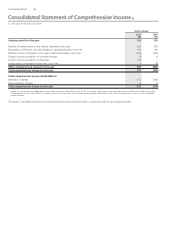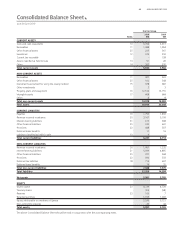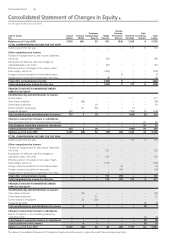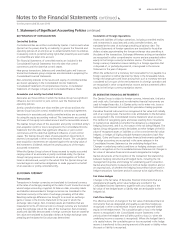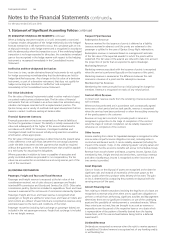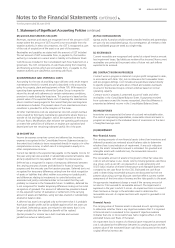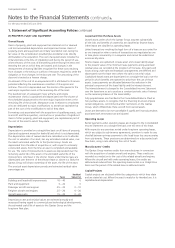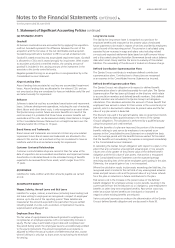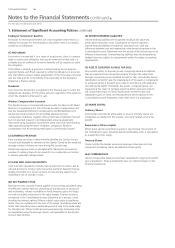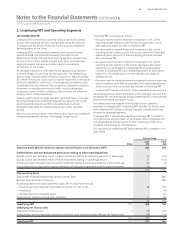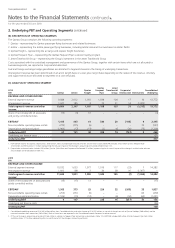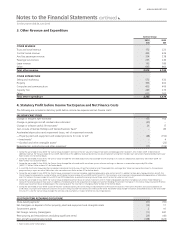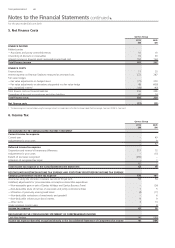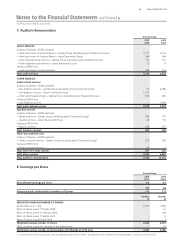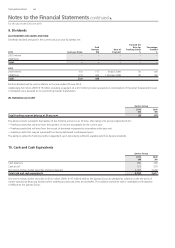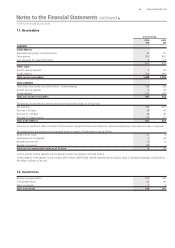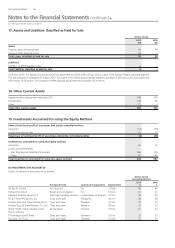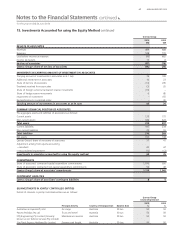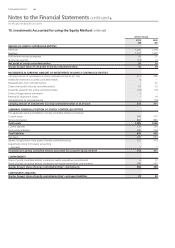Qantas 2010 Annual Report Download - page 60
Download and view the complete annual report
Please find page 60 of the 2010 Qantas annual report below. You can navigate through the pages in the report by either clicking on the pages listed below, or by using the keyword search tool below to find specific information within the annual report.
THE QANTAS GROUP 58
for the year ended 30 June 2010
Notes to the Financial Statements continued
Employee Termination Bene ts
Provisions for termination bene ts are only recognised when there is a
detailed formal plan for the termination and where there is no realistic
possibility of withdrawal.
(T) PROVISIONS
A provision is recognised if, as a result of a past event, there is a present
legal or constructive obligation that can be measured reliably, and it is
probable that an out ow of economic bene ts will be required to settle
the obligation.
If the effect is material, a provision is determined by discounting the
expected future cash ows required to settle the obligation at a pre-tax
rate that re ects current market assessments of the time value of money
and the risks speci c to the liability. The unwinding of the discount is
treated as a nance charge.
Dividends
A provision for dividends is recognised in the nancial year in which the
dividends are declared, for the entire amount, regardless of the extent to
which the dividend will be paid in cash.
Workers Compensation Insurance
The Qantas Group is a licensed self-insurer under the New South Wales
Workers Compensation Act, the Victorian Accident Compensation Act
and the Queensland Workers Compensation and Rehabilitation Act.
Qantas has made provision for all noti ed assessed workers
compensation liabilities, together with an estimate of liabilities incurred
but not reported, based on an independent actuarial assessment
discounted using Australian Government bond rates that have maturity
dates approximating the terms of Qantas’ obligations. Workers’
compensation for all remaining employees is commercially insured.
(U) EARNINGS PER SHARE
Basic earnings per share is determined by dividing the Qantas Group’s
net pro t attributable to members of the Qantas Group by the weighted
average number of shares on issue during the current year.
Diluted earnings per share is calculated after taking into account the
number of ordinary shares to be issued for no consideration in relation
to dilutive potential ordinary shares.
(V) CASH AND CASH EQUIVALENTS
Cash and cash equivalents includes cash at bank and on hand, cash at
call and short-term money market securities and term deposits that are
readily convertible to a known amount of cash and are subject to an
insigni cant risk of change in value.
(W) NET FINANCE COSTS
Net nance costs comprise interest payable on borrowings calculated using
the effective interest method, unwinding of the discount on provisions
and receivables, interest receivable on funds invested, gains and losses
on mark-to-market movement in fair value hedges. Finance income is
recognised in the Consolidated Income Statement as it accrues, using
the effective interest method. Where interest costs relate to qualifying
assets, they are capitalised to the cost of the assets. Qualifying assets are
assets that necessarily take a substantial period of time to be made ready
for intended use. Where funds are borrowed generally, borrowing costs
are capitalised using the average interest rate applicable to the Qantas
Group’s debt facilities.
(X) INTEREST-BEARING LIABILITIES
Interest-bearing liabilities are recognised initially at fair value less
attributable transaction costs. Subsequent to initial recognition,
interest-bearing liabilities are stated at amortised cost, with any
difference between cost and redemption value being recognised in the
Consolidated Income Statement over the period of the borrowings on an
effective interest basis. Interest-bearing liabilities that are designated as
hedged items are subject to measurement under the hedge accounting
requirements.
(Y) ASSETS CLASSIFIED AS HELD FOR SALE
Non-current assets, or disposal groups comprising assets and liabilities,
that are expected to be recovered primarily through sale rather than
through continued use are classi ed as held for sale. Immediately before
classi cation as held for sale, the measurement of the assets or components
of a disposal group is brought up-to-date in accordance with applicable
Accounting Standards. Thereafter, the assets, or disposal group, are
measured at the lower of carrying amount and fair value less costs to
sell. Impairment losses on initial classi cation as held for sale and
subsequent gains or losses on remeasurement are recognised in the
Consolidated Income Statement, even when there is a revaluation.
(Z) SHARE CAPITAL
Ordinary Shares
Incremental costs directly attributable to issue of ordinary shares are
recognised as a deduction from equity, net of any related income tax
bene t.
Repurchase of Share Capital
When share capital recognised as equity is repurchased, the amount of
the consideration paid, including directly attributable costs, is recognised
as a deduction from equity.
Treasury Shares
Shares held by the Qantas sponsored employee share plan trust are
recognised as treasury shares and deducted from equity.
(AA) COMPARATIVES
Various comparative balances have been reclassi ed to align with current
year presentation. These amendments have no material impact on the
Financial Statements.
1. Statement of Signi cant Accounting Policies continued


